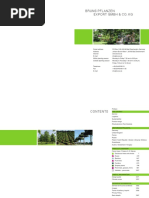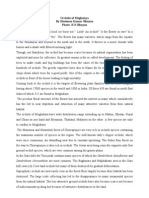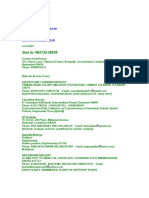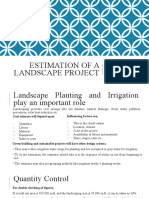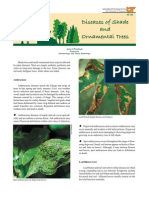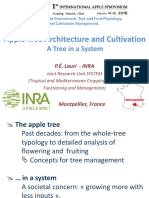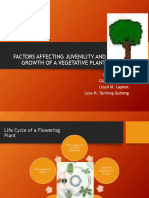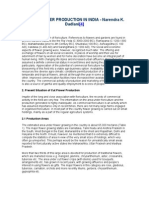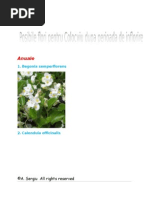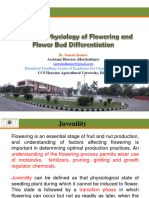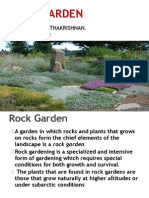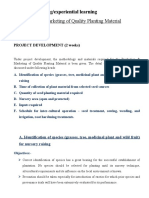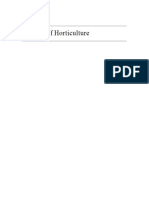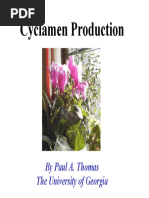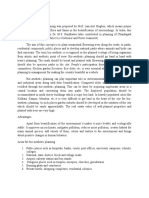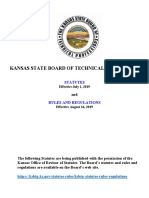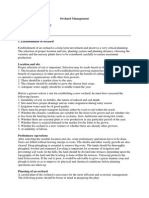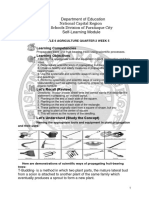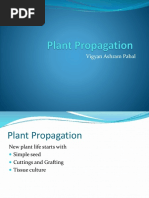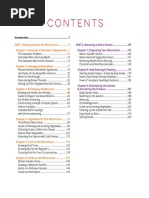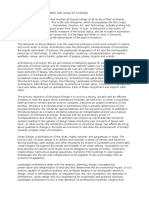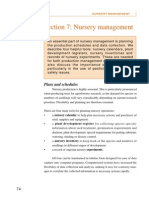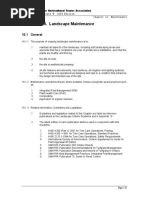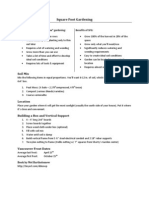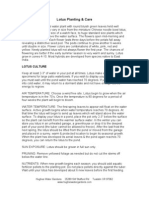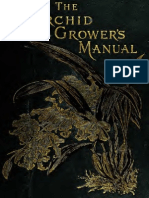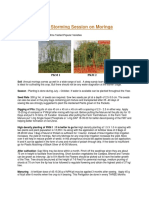Delphinium
Delphinium
Uploaded by
Haider ALiCopyright:
Available Formats
Delphinium
Delphinium
Uploaded by
Haider ALiOriginal Description:
Copyright
Available Formats
Share this document
Did you find this document useful?
Is this content inappropriate?
Copyright:
Available Formats
Delphinium
Delphinium
Uploaded by
Haider ALiCopyright:
Available Formats
Delphinium
Common Name: Larkspur
Botanical Name: Delphinium L. Spp.
Family: Ranunculaceae
Origin: It is native throughout the Northern Hemisphere and also on the high mountains
of Tropical Africa. All the members of Delphinium species are toxic to humans and livestock.
History: The word Delphinium derived from Greek word delphinion ‘larkspur’,
from delphin ‘dolphin’ (because of the shape of the spur, thought to resemble a dolphin's back).
There are many varieties and types of D. elatum in common cultivation as well as probably over
500 other species growing in the wild. In England in Tudor times some of the species grown
were referred to as "larkspur" apparently because the nectary looked somewhat akin to a lark’s
claw. The modern delphinium is the result of hybridization of delphinium species from many
widely varied parts of the world. From the middle of the 19th century, Kelway, Lemoine and
others set about serious breeding greatly improving the number and quality of varieties available.
Since the middle of this century many talented amateur and professional breeders have made
significant contributions to the development of the delphinium. Probably the most notable of
recent times being the English breeder, Duncan McGlashan.
Classification:
Kingdom: Plantae – Plants
Division: Magnoliophyta – Flowering plants
Class: Magnoliopsida – Dicotyledons
Order: Ranunculales
Family: Ranunculaceae – Buttercup family
Genus: Delphinium L. – larkspur
Botany:
The leaves are deeply lobed with three to seven toothed, pointed lobes in a palmate shape. The
main flowering stem is erect, and varies greatly in size between the species, from 10 centimeters
in some alpine species, up to 2 m tall in the larger meadowland species. Flowers of most species
have five spreading sepals and four petals.
Uses:
Delphinium is an herb. People use the flower to make medicine. In landscape, it is used in
Containers, Beds, and Border Flowers and also as Cut Flowers.
Production requirements:
Moist, well-drained loamy soil is best; clay and sand should be amended. Larger seedlings are
preferable for fall plantings to avoid premature flower initiation. Suitable temperature is
77°F/25°C days and 60°F/15°C nights. After transplant, water well to establish the root system.
If roots dry even once, growth will be very poor. Roots also need good aeration to discourage
root rot.
Production Technology:
Seed of Larkspur should be sown in artificial media for rapid germination. The optimum plug
media is well-sterilized peat moss-perlite: vermiculite at ratios 1: 1:3 or 2:0:3 with pH 5.5 to 6.5.
Seeds must be covered as dark is required. Keep wet until germ/root emergence. Pre-cool
treatment of 45°F/7°C, wet and dark for 2 days will help the uniform germination under high
temperature conditions such as summer sowing. Plug finish time is 5 to 6 weeks, with optimal
growing temperatures of 60°-78°F/15°-25°C. Larger seedlings are preferable for fall plantings to
avoid premature flower initiation. Suitable temperature is 77°F/25°C days and 60°F/15°C nights.
After transplant, water well to establish the root system. If roots dry even once, growth will be
very poor. Roots also need good aeration to discourage root rot. Induce flowering with
temperatures higher than 60°-35°F/15°-18°C Extending day length to 16 hours helps flowering
but is not required for flower initiation. Minimum night temperature should be 55°-60°F/13°-
15°C for finishing.
Export and Import:
Delphinium is a major cut flower at international level but is grown on a very small scale. It is
mostly grown in UK. So, exact import and export of this flower is not stated yet.
Planting:
Larkspur should be plat at a spacing of 18-24 inches and it can also be planted in pots.
Propagation:
Seeds, Root division and herbaceous stem cuttings (In spring before flowering) are used for its
propagation.
Fertilizers:
16-16-16 NPK should be used for proper nutrition of larkspur.
Other Cultural Practices:
Stacking: Insert supports no later than mid-spring or when the plants reach 12 inches high. Stake
the low-growing perennials with twiggy, brushwood support. The taller, large-flowered
delphiniums need sturdy stakes. Deadhead by cutting spent flower spikes back to small,
flowering side shoots. After delphiniums have finished blooming, cut flower stalks to the ground,
and new, though smaller, flower stalks will develop.
Pests and Diseases:
Larkspur is susceptible to slugs and snails as well as cyclamen mites. Powdery mildew,
Southern blight, bacterial and fungal spots, gray mold, crown and root rot, white rot, rust, white
smut, leaf smut, and damping off occur.
Harvest and Post-Harvest:
This elegant flower is good for a cutting garden. If you take the blooms into the house as soon as
they open, they will bloom again. Add sugar plus lemon juice and bleach to arrangements of
delphinium. You can also use a commercial flower preservative.
Marketing:
The price of Delphinium per stem is $1.56 per stem.
You might also like
- Bruns Sortimentskatalog 2021-2022 enDocument676 pagesBruns Sortimentskatalog 2021-2022 enFlavia Tothpal100% (1)
- Antirrhinum: Chromosome No: 2n 16Document5 pagesAntirrhinum: Chromosome No: 2n 16kanchana50% (2)
- CREEPERSDocument11 pagesCREEPERSYOJNA JAINNo ratings yet
- Orchids of MeghalayaDocument3 pagesOrchids of MeghalayaRabindra Nath BhuyanNo ratings yet
- Cabbage: Planting GuideDocument3 pagesCabbage: Planting Guidemashitiva67% (3)
- PEDOSPHEREDocument32 pagesPEDOSPHEREKENT YNo ratings yet
- Nurseries in IndiaDocument122 pagesNurseries in IndiaDr. Rama krishna Pulla100% (2)
- Cultivation Practices of TuberoseDocument22 pagesCultivation Practices of Tuberosearunbera00786% (7)
- Antirrhinum FDocument27 pagesAntirrhinum Fkanchana100% (2)
- Estimation of A Landscape ProjectDocument8 pagesEstimation of A Landscape ProjectKasturi Mandal100% (1)
- Lilium ManualDocument8 pagesLilium ManualVikas Bhandari100% (1)
- China Aster 336Document9 pagesChina Aster 336Manish M. RamaniNo ratings yet
- Orchidaceae - WikipediaDocument93 pagesOrchidaceae - WikipediaBashiir NuurNo ratings yet
- O Landscape MaintenanceDocument27 pagesO Landscape Maintenancemrsmech84No ratings yet
- Landscape HorticultureDocument13 pagesLandscape HorticultureHassan JuttNo ratings yet
- Hort 221Document90 pagesHort 221Voice AnonymousNo ratings yet
- Diseases of Shade and Ornamental TreesDocument6 pagesDiseases of Shade and Ornamental TreesSharad BhutoriaNo ratings yet
- Indian GooseberryDocument18 pagesIndian GooseberryManish M. Ramani100% (1)
- Producation Technology of CapsicumDocument40 pagesProducation Technology of CapsicumPravinNo ratings yet
- CyclamenDocument9 pagesCyclamenLAUM1No ratings yet
- TreesDocument6 pagesTreesAR Dimple GauravNo ratings yet
- Loose Flower FLA 503Document13 pagesLoose Flower FLA 503Pratik RautNo ratings yet
- Apple Tree Architecture and Cultivation A Tree in A SystemDocument27 pagesApple Tree Architecture and Cultivation A Tree in A SystemTesema YohanisNo ratings yet
- Nishanth Rao - Dolichos BeanDocument15 pagesNishanth Rao - Dolichos BeanNishanth RaoNo ratings yet
- Factors Affecting Juvenility and Growth of A VegetativeDocument33 pagesFactors Affecting Juvenility and Growth of A VegetativeAlangelico Ortiz San PascualNo ratings yet
- Cut Flowers in IndiaDocument8 pagesCut Flowers in IndiaPunjaji PatilNo ratings yet
- Production Technology of ZantedeschiaDocument60 pagesProduction Technology of Zantedeschiaannappurna83% (6)
- Hort 354Document7 pagesHort 354Vikki NandeshwarNo ratings yet
- 7 Piyush Sharma Vertical Gardens Pp.42 48Document7 pages7 Piyush Sharma Vertical Gardens Pp.42 48Anonymous WlFxuPNo ratings yet
- Production Technology For Ornamental Crops, Maps and LandscapingDocument26 pagesProduction Technology For Ornamental Crops, Maps and LandscapingDr. Praveen SinghNo ratings yet
- Flori ColocviuDocument48 pagesFlori ColocviuFabian PopaNo ratings yet
- MicrograftingDocument1 pageMicrograftingDrRuby Ranjan SharmaNo ratings yet
- Post Harvest Management of Apple and Vale AdditionDocument14 pagesPost Harvest Management of Apple and Vale Additionbenny mosesNo ratings yet
- Sclerocarya Birrea Seed LeafletDocument2 pagesSclerocarya Birrea Seed LeafletHector QuezadaNo ratings yet
- Protected Cultivation of ChrysanthemumDocument51 pagesProtected Cultivation of ChrysanthemumhiteshridalaiNo ratings yet
- 8 Juvenility, Physiology of Flowering and Flower Bud DifferentiationDocument18 pages8 Juvenility, Physiology of Flowering and Flower Bud Differentiationmalhotralavanay19No ratings yet
- Petunia RG314 PDFDocument2 pagesPetunia RG314 PDFLAUM1No ratings yet
- V. NARENDHIRAN, M.SC., (Hort.) - PSMA, Department of Horticulture, Faculty of Agriculture, Annamalai UniversityDocument64 pagesV. NARENDHIRAN, M.SC., (Hort.) - PSMA, Department of Horticulture, Faculty of Agriculture, Annamalai UniversityNarendhiran VNo ratings yet
- Evolution of Garden Design: M.Arch Landscape Assistant Professor GITAM School of Architecture Hyderabad Prepared byDocument23 pagesEvolution of Garden Design: M.Arch Landscape Assistant Professor GITAM School of Architecture Hyderabad Prepared bynihaNo ratings yet
- Rock Garden NavaneethakrishnanDocument31 pagesRock Garden NavaneethakrishnanNavanith Agriculture DeptNo ratings yet
- Milo TreeDocument19 pagesMilo TreeJennifer Williams NourseNo ratings yet
- Landscape PDFDocument47 pagesLandscape PDFRiya BansalNo ratings yet
- Course code:-FSC-506 Course Title:-Prodn Tech of Subtropical and Temperate Crop Credit Hour:-3 (2+1)Document44 pagesCourse code:-FSC-506 Course Title:-Prodn Tech of Subtropical and Temperate Crop Credit Hour:-3 (2+1)Deepak MewarNo ratings yet
- Kigelia Africana IntDocument2 pagesKigelia Africana IntMia Audina MiyanoshitaNo ratings yet
- Production and Marketing of Quality Planting Material: Hands-On-Training/experiential LearningDocument30 pagesProduction and Marketing of Quality Planting Material: Hands-On-Training/experiential LearningKanchanNo ratings yet
- Preview-9789390512188 A41890491Document67 pagesPreview-9789390512188 A41890491TECH MAZENo ratings yet
- CyclamenDocument50 pagesCyclamenLAUM1No ratings yet
- Bouganvillea BRDNGDocument27 pagesBouganvillea BRDNGkanchanaNo ratings yet
- Chapter 1 FinalDocument50 pagesChapter 1 FinalJr AquinoNo ratings yet
- HRT 202 Theory Notes PDFDocument138 pagesHRT 202 Theory Notes PDFআম্লান দত্ত100% (1)
- Annona SquamosaDocument5 pagesAnnona SquamosaPhan Thanh TrangNo ratings yet
- Bio Aesthetic PlanningDocument1 pageBio Aesthetic PlanningMani Hembrom67% (3)
- Landscape PLANTDocument41 pagesLandscape PLANTPrithiv RajanNo ratings yet
- Lecture 27 RambutanDocument5 pagesLecture 27 RambutanGopu ChiyaanNo ratings yet
- Integrated Pest Manage Ment of Flower Crops UnderDocument158 pagesIntegrated Pest Manage Ment of Flower Crops Undervijjumandula100% (1)
- Sansevieria Cylindrica: Family: AsparagaceaeDocument4 pagesSansevieria Cylindrica: Family: AsparagaceaeEmmanuel Veloz TenebrosoNo ratings yet
- Bay 3 Planting and Design Concepts OriginalDocument56 pagesBay 3 Planting and Design Concepts OriginalOUNO VICTOR MAGATANo ratings yet
- UNFRUITFULLNESS BY MahendraDocument84 pagesUNFRUITFULLNESS BY MahendraRathod mahendra100% (2)
- Presentation On Rose and Its Breeding: Submitted To-Submitted byDocument24 pagesPresentation On Rose and Its Breeding: Submitted To-Submitted bynarayananNo ratings yet
- Rose Cultivation 350Document18 pagesRose Cultivation 350amreen_n_sayyed100% (1)
- Intercultural Operations in Cole CropsDocument2 pagesIntercultural Operations in Cole CropsDr.Eswara Reddy SiddareddyNo ratings yet
- BPI Orchid GuideDocument10 pagesBPI Orchid GuideHenry James SisonNo ratings yet
- Dish GardenDocument5 pagesDish GardenabrokenheartedgirlNo ratings yet
- Kansas State Board of Technical Professions: StatutesDocument37 pagesKansas State Board of Technical Professions: StatutesYaredo MessiNo ratings yet
- Plant PropagationDocument11 pagesPlant PropagationAbdul Ola IBNo ratings yet
- Region IV A ISNM Accomplishment Report FY 2020Document13 pagesRegion IV A ISNM Accomplishment Report FY 2020Jofit DayocNo ratings yet
- Orchard ManagementDocument12 pagesOrchard Managementptakawale1987100% (1)
- Ecology of Seed Germination in Threatened TreesDocument24 pagesEcology of Seed Germination in Threatened TreesHumayun BarbhuyanNo ratings yet
- Lecture 5Document28 pagesLecture 5Emil BuanNo ratings yet
- Community Gardening Thrives at Battle Point Pea PatchesDocument2 pagesCommunity Gardening Thrives at Battle Point Pea PatchesAoede ArethousaNo ratings yet
- TLE 6 - Week5Document6 pagesTLE 6 - Week5Luis SalengaNo ratings yet
- Agriculture - Nursery - Plant Propagation and Nursery Management - Presentation - Plant PropogationDocument16 pagesAgriculture - Nursery - Plant Propagation and Nursery Management - Presentation - Plant PropogationPORFERIO WILFREDO BRIVANo ratings yet
- Winter-Spring 2002 Botanical Garden University of California Berkeley NewsletterDocument20 pagesWinter-Spring 2002 Botanical Garden University of California Berkeley NewsletterBotanical Garden University of California BerkeleyNo ratings yet
- List of Flower Names From A To ZDocument7 pagesList of Flower Names From A To ZcatetoNo ratings yet
- The Suburban MicroFarm Table of ContentsDocument2 pagesThe Suburban MicroFarm Table of ContentsChelsea Green PublishingNo ratings yet
- AssignmentDocument11 pagesAssignmentMurali SambhuNo ratings yet
- Conditions of Engagement and Scale of ChargesDocument34 pagesConditions of Engagement and Scale of Chargespragya rajputNo ratings yet
- Site PlanningDocument10 pagesSite Planningsammyyyyy4No ratings yet
- Landscape Design Methods in Architecture PDFDocument14 pagesLandscape Design Methods in Architecture PDFY GaoNo ratings yet
- NurseryDocument5 pagesNurserybyupaNo ratings yet
- CHAPTER 16. Landscape Maintenance: 16.1 GeneralDocument29 pagesCHAPTER 16. Landscape Maintenance: 16.1 GeneralMohamad Nasar Fana100% (2)
- Brick and Tile Permaculture PDFDocument2 pagesBrick and Tile Permaculture PDFDragan LeskovarNo ratings yet
- Square Foot GardeningDocument2 pagesSquare Foot GardeningRichard Davies100% (1)
- LotusDocument2 pagesLotusSulaman HumayunNo ratings yet
- Landscape Architecture: Sustainable Architecture, Softscape, HardscapeDocument23 pagesLandscape Architecture: Sustainable Architecture, Softscape, HardscapeAyon SenguptaNo ratings yet
- The Orchid Grower's ManualDocument1,050 pagesThe Orchid Grower's ManualAna Irina Crînganu100% (5)
- Insight 1 Site Planning and Landscape Architecture Bayugo Ovid Shiaster M. Arc 3201Document3 pagesInsight 1 Site Planning and Landscape Architecture Bayugo Ovid Shiaster M. Arc 3201Ian EncarnacionNo ratings yet
- Brain Storming Session On MoringaDocument2 pagesBrain Storming Session On MoringakrazypopNo ratings yet
- Chapter Three Landscaping and HorticultureDocument8 pagesChapter Three Landscaping and HorticultureSamson DeCasparNo ratings yet
- Omoya-Onyege: Summary of Field Density Test Results (Earthworks)Document15 pagesOmoya-Onyege: Summary of Field Density Test Results (Earthworks)MartinNo ratings yet
